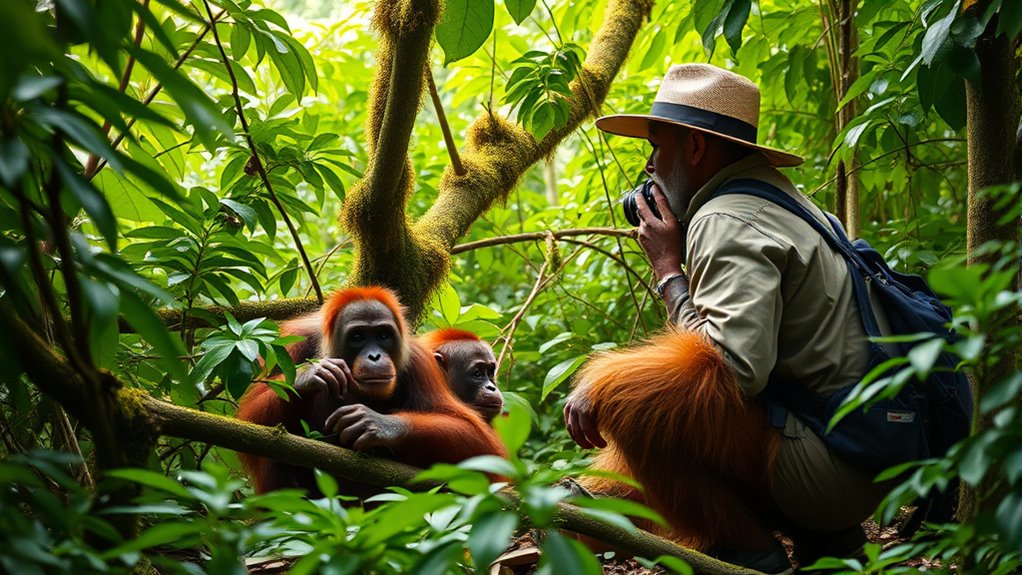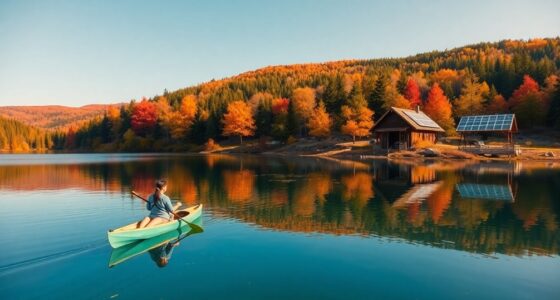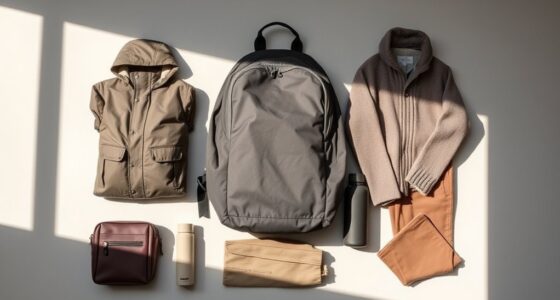To practice responsible wildlife photography, respect animals’ natural behaviors and habitats by keeping a safe distance and avoiding disturbance. Use long lenses, quiet equipment, and avoid flash or baiting to minimize impact. Follow local laws, obtain permits, and stick to designated paths. Prioritize animal well-being over getting perfect shots and leave no trace behind. If you continue exploring, you’ll discover how to blend artistry with ethical practices for truly sustainable photography.
Key Takeaways
- Respect animals’ natural behavior and habitat by maintaining a safe distance and avoiding habitat disturbance.
- Use appropriate equipment like long lenses and silent cameras to minimize disturbance and ensure responsible photography.
- Follow local laws, obtain necessary permits, and adhere to regulations to protect wildlife and habitats.
- Avoid baiting, feeding, or manipulating animals to capture images, prioritizing their well-being over photography goals.
- Practice Leave No Trace principles, packing out all trash and staying on designated trails to preserve the environment.
Respect the Animals’ Natural Behavior and Habitat

To capture authentic wildlife moments, you need to prioritize respecting animals’ natural behavior and habitat. This approach supports wildlife conservation by minimizing disturbances that could stress or alter their routines. Avoid getting too close or making sudden movements that might scare animals away or cause them harm. By observing from a respectful distance, you help preserve their habitat and ensure their environment remains undisturbed for future generations. Remember, habitat preservation is vital for maintaining healthy ecosystems and supporting biodiversity. Your patience and quiet presence encourage the animals to behave naturally, resulting in more genuine photographs. Respectful behavior not only benefits wildlife but also enhances your experience, allowing you to document their lives authentically without interfering in their world. Practicing ethical wildlife photography ensures the conservation of their habitats and promotes a deeper understanding and appreciation of wildlife.
Maintain a Safe Distance From Wildlife
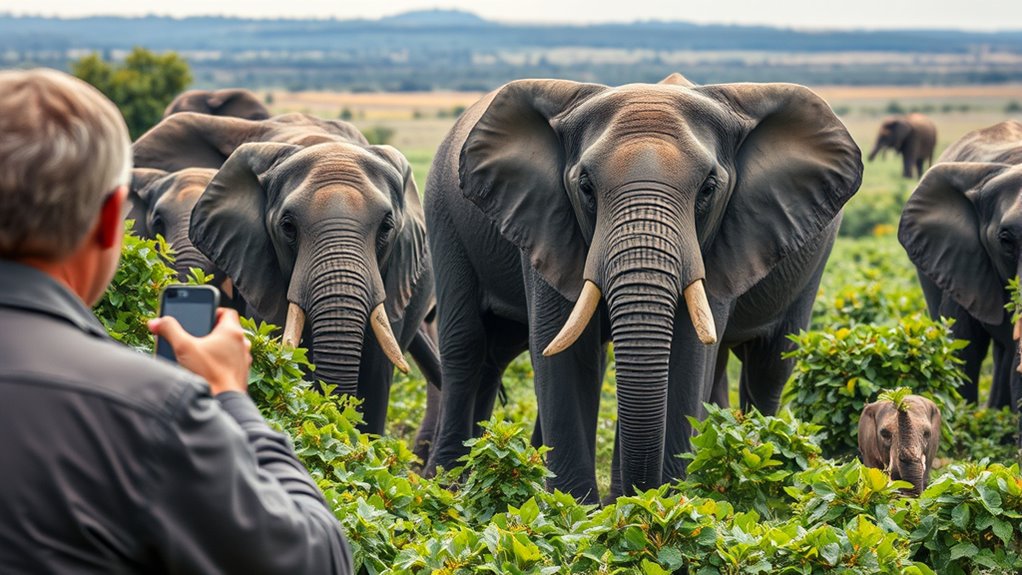
Maintaining a safe distance from wildlife is essential for both your safety and the animals’ well-being. Getting too close can cause wildlife harassment, stressing or disrupting their natural behavior. Respecting ethical boundaries means avoiding intrusive actions that may disturb their habitat or cause harm. Keep a respectful distance to prevent frightening or provoking animals, which can lead to unpredictable or dangerous situations. Using binoculars or telephoto lenses allows you to observe and photograph wildlife without encroaching on their space. Remember, your goal is to capture authentic moments without causing stress or disturbance. By maintaining this boundary, you protect the animals and ensure that your photography remains ethical and responsible. Always prioritize the animals’ comfort over getting the perfect shot. Additionally, understanding the horsepower of electric dirt bikes can help you appreciate the power and agility of wildlife in motion, fostering a deeper respect for their natural abilities.
Use Appropriate Equipment to Minimize Disturbance

Using the right equipment helps you observe wildlife without causing stress. Choose long lenses to keep your distance, and opt for silent cameras to avoid startling animals. Additionally, skip flash photography, which can disturb wildlife and their habitats. Proper cleaning and maintenance of your camera equipment also ensure optimal performance and reduce the risk of malfunctions during critical moments, especially when using delicate or specialized gear such as adjustable settings.
Opt for Long Lenses
Opting for long lenses allows you to capture wildlife from a safe distance, reducing the risk of disturbing animals and their natural behaviors. Using telephoto lenses helps you stay unobtrusive while still getting detailed shots. Make sure your camera ergonomics are comfortable, so you can hold long lenses steadily, preventing unnecessary movements that might startle animals. Regular lens maintenance is essential to keep your equipment functioning smoothly, ensuring sharp images without needing to get closer. Long lenses also minimize the need to approach wildlife directly, helping you observe behaviors authentically. Always carry your gear carefully and keep your lenses clean. Proper equipment maintenance ensures your gear performs optimally, allowing you to focus on capturing authentic moments responsibly. By choosing appropriate equipment and maintaining it well, you respect wildlife and improve your chances of capturing genuine moments responsibly.
Use Silent Cameras
To minimize disturbance to wildlife, selecting silent cameras or equipment with quiet operation is essential. Silent cameras help you capture natural behaviors without startling animals or disrupting their environment. By reducing noise, you maintain wildlife silence, allowing animals to behave normally and ensuring your presence remains unobtrusive. Modern silent cameras are designed specifically for discreet photography, making them ideal for sensitive habitats. When choosing equipment, prioritize models with minimal shutter noise and fast focus to avoid unnecessary disturbance. Using silent cameras not only benefits the animals but also improves your chances of capturing authentic, candid moments. Recognizing the importance of ethical photography practices ensures you respect wildlife and their habitats, promoting responsible behavior in nature. Remember, respecting wildlife involves minimizing your impact, and quiet, unobtrusive gear plays a key role in responsible photography.
Avoid Flash Photography
Ever wonder how flash photography can disturb wildlife? Flash disturbance can cause animal stress, making them feel threatened or disoriented. To minimize this, use appropriate equipment that limits flash use or employs natural light. Here are four ways to reduce impact:
- Opt for silent, high-quality cameras to avoid startling animals.
- Use long lenses to keep your distance and prevent flash disturbance.
- Turn off the flash completely when possible, relying on available light.
- Plan your shots during daylight or in low-light conditions to eliminate the need for flash.
- Be aware of cookie management practices to respect privacy and minimize unnecessary data collection during your photography sessions.
Avoid Staking Out Animals for Extended Periods
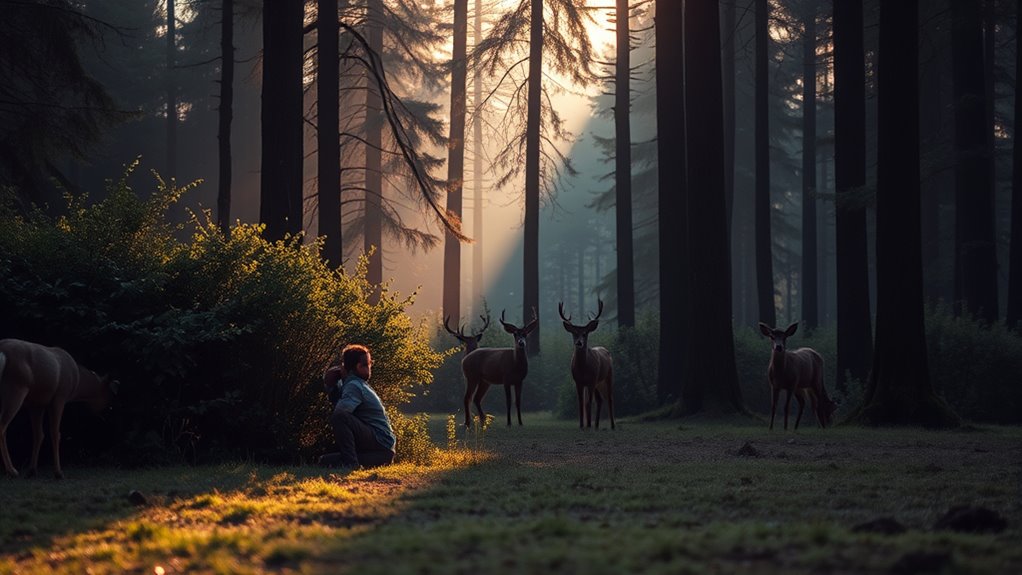
Staking out animals for long periods can disturb their natural behaviors and increase stress, making it harder to observe genuine wildlife activity. Extended observation may lead to animal habituation, where animals become accustomed to your presence, potentially altering their natural responses. While long-term observation can provide valuable insights, it’s essential to limit your time in one spot to avoid causing undue disturbance. Instead, plan shorter visits and move quietly to minimize impact. Remember, your goal is to document authentic behavior without influencing it. By respecting the animals’ space and avoiding prolonged stays, you help preserve their natural routines and reduce stress. Incorporating water conservation practices, such as minimizing unnecessary movements, further supports wildlife preservation. Responsible wildlife photography balances the need for observation with the animals’ well-being, ensuring your presence doesn’t become a disturbance.
Be Mindful of the Environment and Leave No Trace
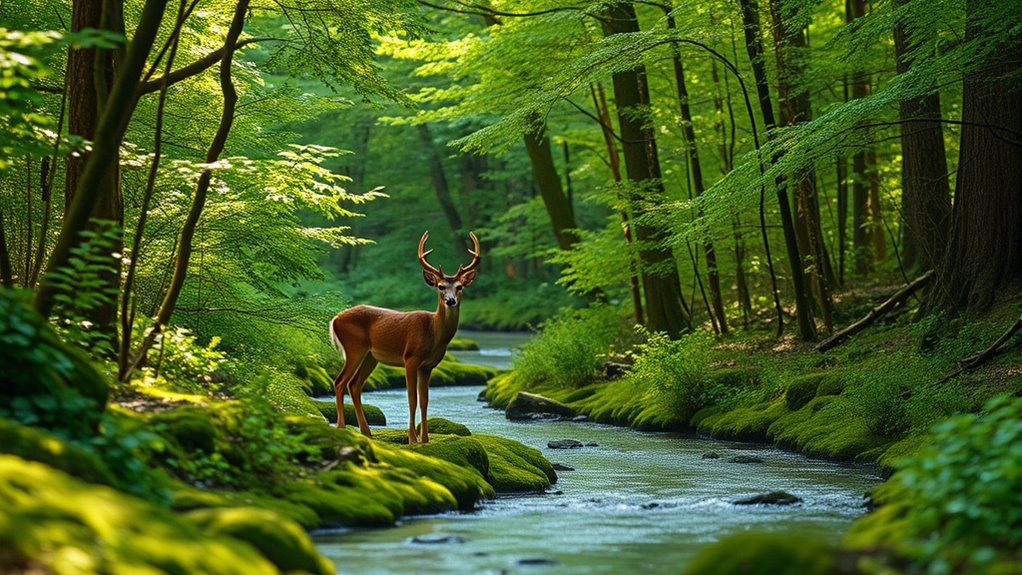
Being mindful of the environment is essential when wildlife photography, as your presence can unintentionally cause harm or disruption. To support environment preservation, always practice Leave No Trace principles. Your goal should be to enjoy and document wildlife without leaving a lasting impact. Consider these key actions: 1. Pack out all trash and belongings—nothing should be left behind. 2. Stick to established trails to prevent habitat damage. 3. Avoid disturbing animals or their nests, maintaining a respectful distance. 4. Minimize noise and movement to reduce stress on wildlife. Additionally, understanding the importance of color accuracy in capturing true-to-life images can help you document wildlife more ethically and effectively.
Seek Permits and Follow Local Regulations

Before you start shooting, make certain to research local laws and obtain any required permits. This helps you stay compliant and avoid fines or disruptions. Always respect protected areas and follow regulations to ensure wildlife and habitats remain safe. Additionally, understanding forsale 100 can help you in sourcing equipment or resources responsibly.
Research Local Laws
Researching local laws is a crucial step before heading out for wildlife photography, as it guarantees you stay within legal boundaries and respect protected species. Ignoring regulations can inadvertently support illegal activities like wildlife trafficking or encourage harmful practices such as illegal local hunting. By understanding laws, you help protect fragile ecosystems and endangered species. Additionally, being aware of essential oil safety guidelines can help you avoid inadvertently disturbing wildlife with scented products or other residues.
Here’s what you should do:
- Check protected species lists to avoid photographing or disturbing them.
- Learn about local hunting seasons and restrictions to prevent conflicts.
- Research regulations on drone use to prevent disturbance or illegal surveillance.
- Be aware of laws concerning wildlife trafficking to ensure your photography doesn’t contribute to it.
Staying informed not only keeps you safe but also champions the preservation of wildlife for future generations.
Obtain Necessary Permits
Have you obtained the necessary permits before heading into wildlife areas? Making sure you follow permit requirements is vital for responsible wildlife photography. Understanding the permit application process helps you stay compliant with local regulations and demonstrates respect for wildlife photography ethics. Many protected areas and reserves require permits to access sensitive habitats or to photograph certain species. Skipping this step can lead to fines or damage your reputation as a respectful photographer. Before your trip, research the specific permits needed and submit your application well in advance. Keep documentation handy during your shoot, and always adhere to any restrictions outlined in your permit. Following these guidelines ensures your photography remains ethical and sustainable, supporting conservation efforts and respecting the environment.
Respect Protected Areas
Respecting protected areas starts with understanding and following the rules set by authorities. Your actions directly impact wildlife conservation and habitat preservation. To guarantee your photography respects these spaces, keep in mind:
- Seek necessary permits before entering protected zones, showing respect for regulations.
- Stay on designated paths to avoid damaging habitats and disturbing wildlife.
- Avoid loud noises and sudden movements that can scare or stress animals.
- Leave no trace—pack out all your trash and equipment, maintaining the area’s integrity.
Practice Ethical Composition and Avoid Baiting
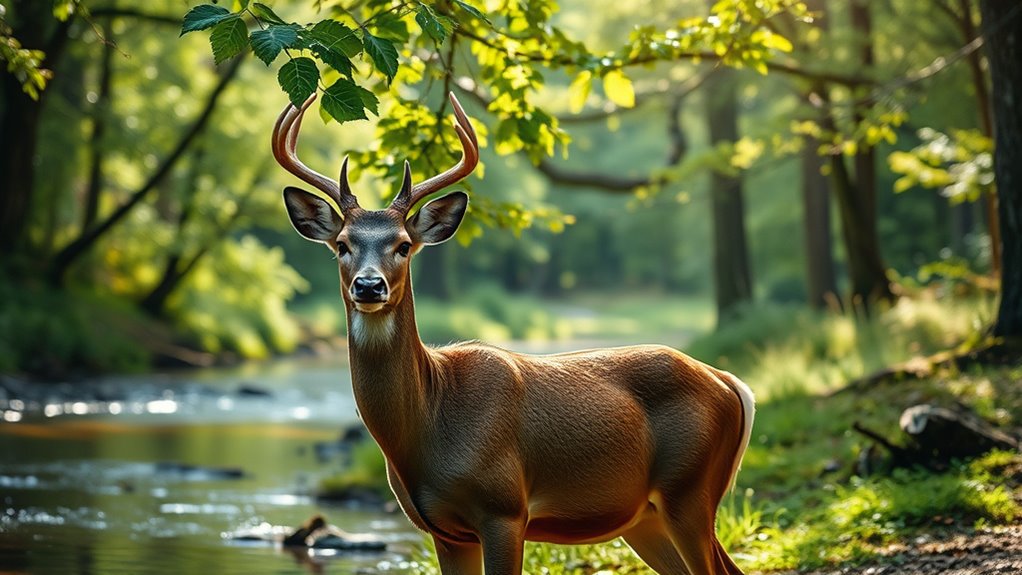
Practicing ethical composition is essential to guarantee your wildlife photographs do not disturb or harm the animals you’re observing. To uphold baiting ethics, avoid using food or other attractants that can alter animal behavior or create dependency. Instead, focus on composition techniques that respect the animal’s natural environment and behaviors. Keep a respectful distance to prevent causing stress or displacement. Use natural framing, leading lines, and perspective to capture compelling images without invasive tactics. Remember, your goal is to showcase wildlife authentically and responsibly, so prioritize the animal’s well-being over getting the perfect shot. By adhering to these principles, you help preserve natural behaviors and ensure your photography contributes positively to wildlife conservation.
Prioritize the Well-being of Subjects Over Shots
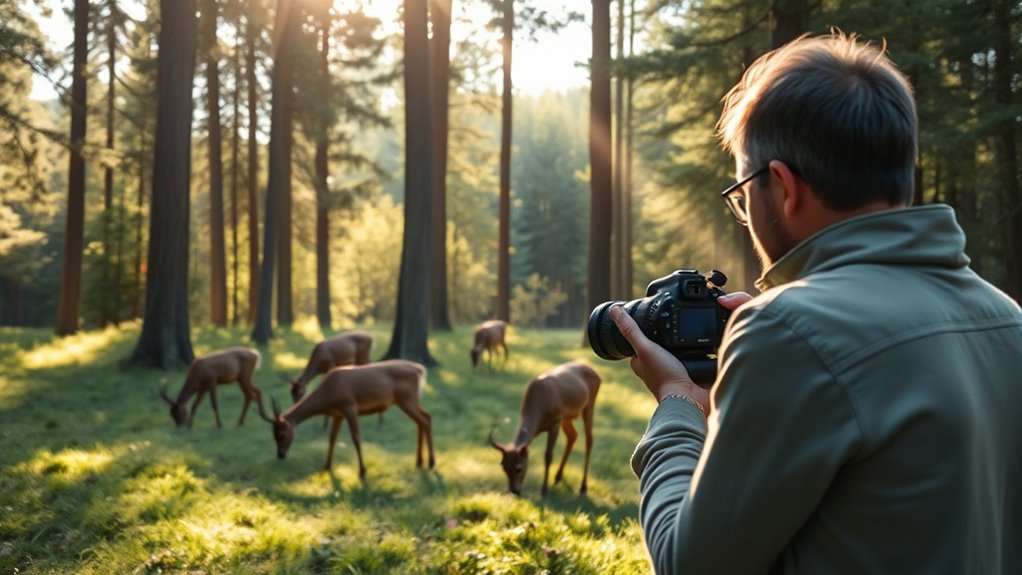
While capturing stunning wildlife images is rewarding, prioritizing the well-being of your subjects should always come first. Your goal is to support wildlife conservation and tell ethical stories, not to disturb or stress animals. Keep these priorities in mind:
- Respect their space—avoid encroaching on their habitat or causing alarm.
- Observe quietly—minimize noise that could disrupt natural behaviors.
- Limit interference—refrain from tempting animals or altering their environment.
- Be patient—wait for genuine moments instead of forcing shots, ensuring animals aren’t harmed or distressed.
Share and Promote Responsible Photography Practices

Sharing your wildlife photographs responsibly helps guarantee that others understand the importance of ethical practices and conservation. When you promote responsible photography practices, you support wildlife conservation efforts and reinforce photography ethics. By sharing images thoughtfully, you set an example for fellow enthusiasts and encourage respectful interactions with nature. Avoid disturbing animals or their habitats, and include context that highlights conservation issues. Use your platform to educate others about ethical guidelines, emphasizing the importance of minimizing impact and respecting wildlife. When you promote responsible practices, you contribute to a culture that values the well-being of animals and their environments. Ultimately, your responsible sharing helps foster a deeper appreciation for wildlife and the need to protect it for future generations.
Frequently Asked Questions
How Can I Identify When I Am Causing Stress to Wildlife?
You can tell when you’re causing stress to wildlife by observing their animal behavior and stress signals. If animals suddenly become more alert, move away quickly, or show signs of agitation like raised fur or vocalizations, you’re likely stressing them. Keep a respectful distance, watch for subtle cues, and avoid sudden movements. By paying attention to these stress signals, you guarantee your presence doesn’t negatively impact their natural behavior.
What Are the Best Ways to Educate Others About Ethical Wildlife Photography?
Think of yourself as a storyteller who can sway hearts and minds. To educate others about ethical wildlife photography, you should share your experiences and emphasize ethical storytelling. Engage your community through workshops, social media, or local events, highlighting the importance of respecting wildlife. When you lead by example, you plant seeds of awareness that grow into a community committed to responsible, compassionate photography, ensuring nature’s stories are told with care.
How Do I Handle Situations Where Wildlife Approaches Me Unexpectedly?
When wildlife approaches you unexpectedly due to their curiosity, stay calm and avoid sudden movements. Let the animal come closer if it wishes, but don’t pursue it. Keep your distance and observe its behavior, showing respect for its space. Remember, these unexpected encounters are natural expressions of wildlife curiosity. By remaining patient and composed, you guarantee both your safety and the animal’s well-being, fostering positive, respectful interactions.
Are There Specific Times of Day That Are Better for Responsible Photography?
You should consider shooting during dawn photography or dusk sessions, as these times often offer the best natural lighting and fewer animals are disturbed. Early mornings and late evenings create softer, more diffused light, reducing stress on wildlife. By planning your shoots around these times, you can capture stunning images while respecting animals’ natural behaviors and habitats, ensuring responsible wildlife photography.
How Can I Ensure My Photography Does Not Disrupt Local Ecosystems?
To prevent disrupting local ecosystems, you should minimize habitat disturbance and avoid feeding interference. Stay on designated paths to protect habitats, and keep a respectful distance from animals to avoid stressing or altering their natural behaviors. Refrain from offering food, as it can lead to dependency or aggression. By observing quietly and respecting wildlife boundaries, you guarantee your photography doesn’t harm the ecosystems you’re capturing.
Conclusion
By embracing these responsible wildlife photography guidelines, you become a guardian of nature’s delicate dance. Like a gentle breeze that honors the forest’s secrets, your respectful approach preserves wildlife’s natural rhythm. Let your images tell stories without disturbing the peace, and in doing so, you become a steward of the wild. Remember, every click is a promise—protect their world as fiercely as you chase the perfect shot, ensuring future generations can marvel at nature’s unseen wonders.

